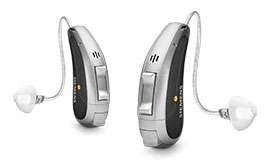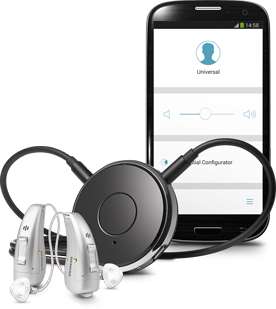Siemens introduces smart hearing aids

At the 2015 International CES, Siemens is unveiling smart hearing aids—their latest in wearable hearing technology. The hearing aids can be discreetly controlled via both iPhone and Android devices, with latest models clinically proven to outperform people with normal hearing in background noise. When two hearing aids are worn (the most common case), Siemens' new smart hearing aids utilize intelligent, two-way wireless communication to zero in on desired speech with pinpoint accuracy. This enables better-than-normal hearing in crowded situations like noisy restaurants and cocktail parties where background chatter has historically been a challenge.
"These are not your average hearing aids but rather highly-intelligent wearable devices," said Scott Davis, CEO Siemens Hearing Instruments. "They automatically detect everyday listening environments such as a noisy room, wind, or while driving a car, and instinctively know what to do."
When paired with Siemens' new easyTek and easyTek App, a wearer can control the direction of the hearing aids' microphones—front, left, right, or behind—to simultaneously enhance speech and suppress background noise. The span of the microphones' focus can also be controlled via the app, allowing wearers to select a wide range of focus or a very narrow beam.
"Some hearing aid wearers also want the flexibility that comes with having control over their listening experience," added Davis. "We've all heard of and can appreciate the benefits of on-demand TV. With these hearing aids, you can turn your iPhone or Android device into a hearing aid control center. We call it on-demand hearing."
While Siemens' new smart hearing aids pair with virtually any iOS or Android mobile device for a custom-tailored listening experience, a smartphone is not required to make use of the new technology. The hearing aids continuously scan the acoustic environment and activate the most optimal settings for that particular listening situation. For example, if you're at a noisy family gathering, the smart hearing aids hone in on speech coming from the front while softening speech and noise from other directions. Later, if you're out walking the dog, they automatically adjust so you can enjoy the sounds of nature.

Because both hearing aids are in constant communication and processing sound simultaneously, this creates a high-definition surround sound listening experience, with no manual adjustments required.

More information: us.hearing.siemens.com/ces/
Provided by Siemens



















